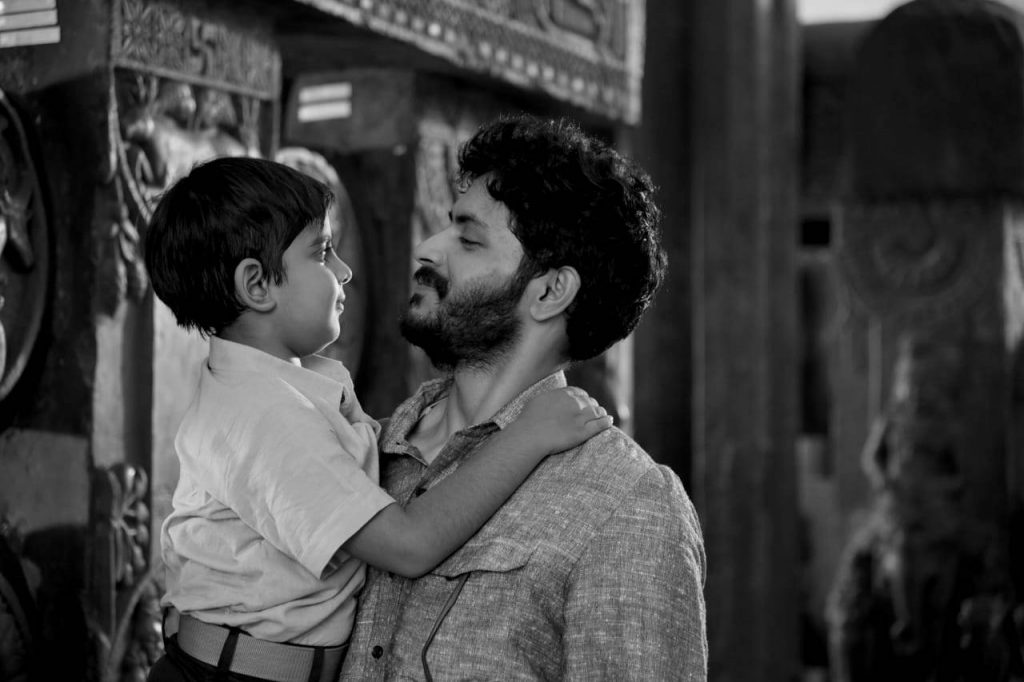More than sixty years after Apur Sansar (1959), the final film of Satyajit Ray’s masterful Apu trilogy, filmmaker Subhrajit Mitra rather courageously takes up the challenge of making his own sequel to Apur Sansar. The end result is Avijatrik: The Wanderlust Of Apu. The film is based on the second half of the original novel by Bibhutibhushan Bandopadhyay, Aparajito, which opens when Ray’s Apur Sansar ends.
Apu (Arjun Chakraborty) is a born dreamer, but happily takes on the responsibility of being a single parent to his little boy, Kajol, taking him along to wherever he travels, sometimes to join a job he is not really interested in, or, buying some rabri for the boy on the ghats of Benares and watching with deep affection when the little Kajol laps it up with his fingers. On his way to join as head master in a school in a small town away from Kolkata, Apu meets his old friend, Leela (Arpita Chatterjee), who was once in love with him. Tragically, Leela is dying and this is their last meeting. In Benares, after Leela is cremated by her brother and her mother grieves for the daughter who could never find out what she wanted in life, Apu meets an elderly man (Sabyasachi Chakraborty), who is a known globe-trotter and who invites Apu to join him in his onward journey. Apu’s first novel becomes a hit and the old publisher – Barun Chanda in an outstanding cameo with a complete image makeover – visits him to offer him an advance for his next book, all of Rs 100. But all this leaves Apu quite indifferent though he has always wanted to be a writer. His deceased wife, Aparna, who died in childbirth ‘visits’ him and coaxes him to pick up his pen and begin to write…
Avijatrik sets up its mood right from the beginning with beautiful charcoal sketches of the father-son duo walking through the kash fields and wandering across the country as the film’s opening credits come up. The sound of the train’s whistle as it chugs its way through the tracks evolves into a physical reality in Apu’s and Kajol’s life while also functioning as a metaphor for the wanderlust that pulls Apu to his old home in Nischindipur to his childhood memories on the one hand and to his uncertain journey into the unknown on the other. However, the Nischindipur phase is not entirely satisfying as it indulges in some could-have-been-avoided melodrama with a lot of tears and sweet-syrupy scenes and also a Durga Pooja thrown in as the regular cliché in Bengali cinema. The touch of Ranu-di in Nischindipur having held on to the notebook Apu scribbled stories in as a small boy with the camera closing in on the childish handwriting, though, is heartwarming to say the least.
Though immortalised by Soumitra Chatterjee, Arjun Chakraborty makes the role of Apu his own, seamlessly slipping into the character as if he was born to portray it. Which is saying a lot. He captures the quiet, pensive and highly introspective arcs of his character perfectly. Sometimes, he allows a tiny smile to crinkle up his eyes specially when he is with Kajol. Arpita Chatterjee as the dying Leela enacts her role extremely well but her make-up does not have the slightest hint of her sorry state of health. Sabyasachi Chakraborty is a bit on the louder side as the veritable globe trotter but this is perhaps done intentionally to counter the quietude Apu wraps himself in. Ditipriya Roy as Aparna is a surreal presence but the impact is an imposition on the narrative and sometimes raises the question of whether the film needed her at all because Apu is already complete in himself.
The period of the film, which takes us back to different parts of then undivided Bengal and just before and during World War II, is enriched with much attention to fine detailing by Production Designer, Gautam Basu. This has been made further possible because Mitra has chosen to shoot the film in Black-and-White. Cinematographer Joy Supratim exquisitely captures the entire canvas off blacks, whites and greys with subtle touches that never overwhelm and yet enchant the audience with their own magic. The ghats of old Benares, its narrow lanes and by lanes, Apu stepping into the home his father came in as a priest to encounter a courtesan are touched as if with gentle, feather-like strokes of the camera. The old Howrah Railway Station as it existed during the late 1940s is relived from pictures available at the Railway Museum. Besides, Kolkata had cobbled streets then and Mitra along with Gautam Basu effectively recreated the period including the old steam and coal-drawn engines and old trains created beautifully through CGI images which look natural. The radio, too, adds to the vintage effect when one hears the news on the BBC with Winston Churchill announcing World War II. The editing appropriately keeps pace with the languid spacing of the film but does at times tell on the length of the film.
For all its strengths, the biggest drawback of the film that pulls it several notches down from the high pedestal it places itself in through excellence in other areas is the very loud music and sound track, which strips the film almost completely of silence which the story and the characters, specially Apu, strongly demand. Anushka Shankar’s reworking on Ravi Shankar’s original signature tune, too, fails to lift the musical score of the film.
Avijatrik, completed in 2020, was screened to two full houses at the recently concluded 26th Kolkata International Film Festival. No doubt, the film establishes Subhrajit Mitra as a filmmaker to look out for.
Bengali, Drama, Black & White


